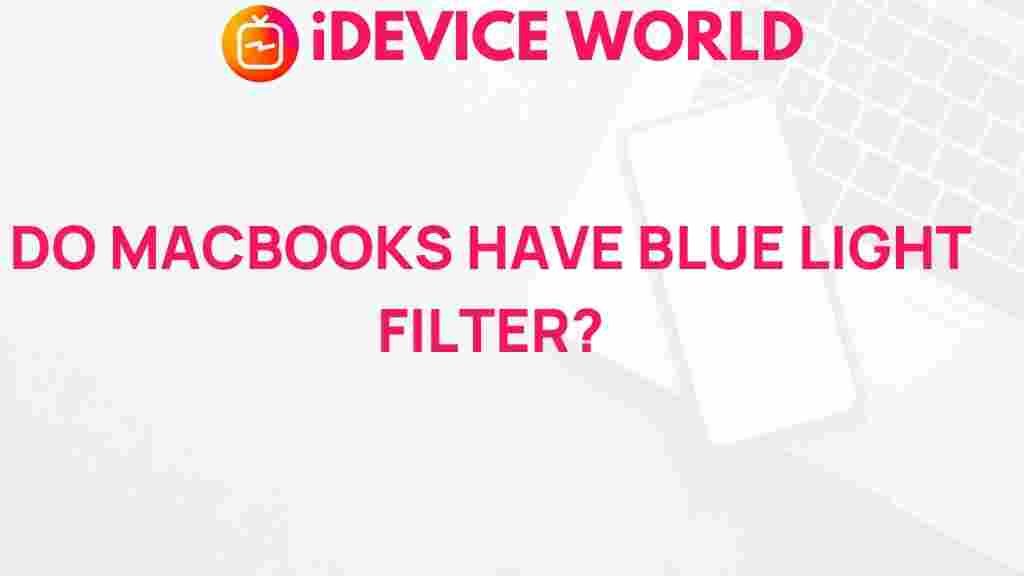Uncovering the Truth: Do MacBooks Really Have Blue Light Filters?
As we spend more time in front of screens, the topic of blue light exposure has become increasingly important. Many users wonder if their devices, such as MacBooks, come equipped with features that can help reduce blue light exposure and alleviate potential eye strain. In this article, we will delve into the details of whether MacBooks truly have blue light filters, the benefits of these filters, how to enable them, and troubleshooting tips for users.
Understanding Blue Light
Before we explore MacBooks and their capabilities, it’s essential to understand what blue light is. Blue light is a high-energy visible light that is emitted from various sources, including:
- Sunlight
- LED lights
- Smartphones
- Tablets
- Laptops and desktop computers
This type of light is known to disrupt sleep patterns, cause eye strain, and potentially lead to long-term vision problems. As a result, many users are actively seeking ways to limit their exposure to blue light.
Do MacBooks Have Blue Light Filters?
The short answer is yes, MacBooks do have built-in blue light filtering capabilities. This feature is part of Apple’s Night Shift mode, which automatically adjusts the color temperature of your display to reduce the amount of blue light emitted during the evening hours.
How to Enable Blue Light Filters on Your MacBook
Enabling the blue light filter on your MacBook is a straightforward process. Follow these steps:
- Click on the Apple menu in the top left corner of your screen.
- Select System Preferences.
- Click on Displays.
- Navigate to the Night Shift tab.
- Here, you can adjust the color temperature slider to your preference.
- Set a schedule for Night Shift to activate automatically or enable it manually.
Once activated, your MacBook will adjust its display to reduce blue light emission, helping to minimize eye strain and improve sleep quality.
Benefits of Using Blue Light Filters
Utilizing blue light filters on your MacBook can offer several benefits:
- Reduced Eye Strain: Many users report less discomfort and fatigue when using blue light filters, particularly after long hours of screen time.
- Improved Sleep Quality: Reducing blue light exposure in the evening can help regulate your circadian rhythm, making it easier to fall asleep.
- Increased Comfort: The warmer tones of filtered light can create a more pleasant viewing experience, especially in low-light conditions.
Is Night Shift the Only Option for Blue Light Filtering?
While Night Shift is the built-in feature for MacBooks, there are additional software and hardware options available for users seeking further blue light reduction:
- Third-Party Apps: Applications like f.lux provide advanced settings for blue light filtering, allowing users to customize their experience beyond what Night Shift offers.
- Screen Protectors: Physical screen protectors with blue light blocking technology can be applied to your MacBook to reduce exposure further.
Troubleshooting Blue Light Filter Issues
If you encounter problems with the blue light filter on your MacBook, here are some troubleshooting tips:
- Ensure Night Shift is Enabled: Double-check that Night Shift is turned on and the schedule is set correctly.
- Check Display Settings: Make sure that no other display settings are interfering with Night Shift functionality.
- Update macOS: Keeping your operating system updated can resolve bugs and issues related to Night Shift.
- Restart Your MacBook: Sometimes, a simple restart can fix minor glitches.
Additional Considerations for Eye Health
While utilizing blue light filters on your MacBook can significantly reduce eye strain, it’s also essential to adopt other practices to promote eye health:
- The 20-20-20 Rule: Every 20 minutes, take a 20-second break to look at something 20 feet away.
- Maintain Proper Lighting: Use adequate lighting while working on your MacBook to reduce glare and eye strain.
- Regular Eye Exams: Schedule routine visits with an eye care professional to monitor your eye health.
Conclusion
In conclusion, MacBooks do indeed come with blue light filtering capabilities through the Night Shift feature, making it easier for users to manage their exposure to blue light. By enabling this feature and considering additional methods to reduce blue light exposure, you can enhance your overall comfort and eye health while using your MacBook. For more tips on maintaining eye health and screen time management, check out our related articles here.
For further reading on the science behind blue light and its effects on health, visit this resource.
This article is in the category Reviews and created by iDeciveWorld Team
